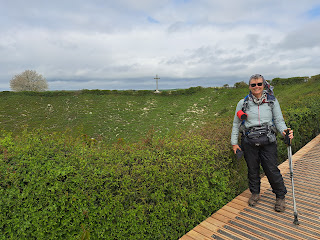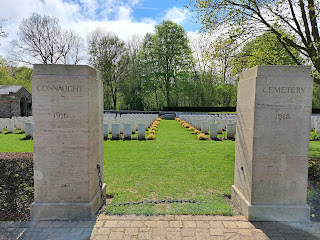Being a pilgrim, one can do more than walk - one can walk to.
- Zygmunt Bauman, From Pilgrim to Tourist (1996)
I recently read a definition of pilgrimage as walking with a purpose. My purpose, in this part of northern France, and indeed since the third day of my Long Walk in England last year, when I passed through my great-grandfather's native village in northern England, has been to walk to his grave in the battlefields of the Somme. Today, I accomplished that purpose.
I left my bed and breakfast in the former train station at Bernafray Wood and walked along the verge of the D64 to the nearby village of Montauban-de-Picardie, where a monument to the Liverpool and Manchester Pals, who liberated the village on the first day of the Somme, stands by the roadside.
It was starting to sprinkle and I stopped under the shelter at Dantzig Alley Cemetery just up the road to put on my waterproof trousers. Once again this technique worked: it stopped raining instantly and didn't rain again all day!
I had a look through the cemetery register and didn't find any potential relations, though I did find a possible relative of Paul McCartney!
I walked through Mametz and on to Fricourt, skirting the village to stop at the German cemetery. 17,027 men are buried here. Thousands and thousands more died in the area and their bodies were never recovered, as the French were far from meticulous in recovering enemy corpses and giving them proper burial...
The German cemeteries are quite different from the Allied ones. There is one simple black iron cross for every four men, their names written on either side of the two arms of the cross.
Germans and Jews fought side by side, and were buried side by side. No-one could imagine what would happen only a few short years later, when the world was once again torn by war.
The GRP - provincial long-distance paths - are marked with the same symbols as the national ones, but in yellow. I followed the symbols of the GRP Bataille de la Somme through the fields to Lochnagar Crater.
The First Day of the Somme, and Lochnagar Crater
The British secretly tunnelled under the German lines in preparation for the first day of the battle of the Somme, and packed the tunnels with an enormous charge of explosives. The mine was sprung at 7:28 a.m. on 1 July 1916 and left a crater which was initially 80 metres deep and about 159 metres wide, now reduced to 21 metres deep and 100 metres wide, which was captured and held by British troops. Cecil Lewis observed the explosion from his aircraft, which was hit by lumps of mud from the explosion:
We were over Thiepval and turned south to watch the mines. As we sailed down above all, came the final moment. Zero! At Boisselle the earth heaved and flashed, a tremendous and magnificent column rose up into the sky. There was an ear-splitting roar, drowning all the guns, flinging the machine sideways in the repercussing air. The earthly column rose, higher and higher to almost four thousand feet. There it hung, or seemed to hang, for a moment in the air, like a silhouette of some great cypress tree, then fell away in a widening cone of dust and debris. A moment later came the second mine. Again the roar, the upflung machine, the strange gaunt silhouette invading the sky. Then the dust cleared and we saw the two white eyes of the craters. The barrage had lifted to the second-line trenches, the infantry were over the top, the attack had begun.
The site is now a memorial, and a commemoration is held at 7:28 on the first of July every year. It is privately owned and run, and not nearly as well cared for as the CWGC memorials. In fact, the boardwalk is badly in need of repair. I walked around the perimeter of the crater, and talked to a Welshman and his daughter who visit the Somme every year. He is a collector of medals and other memorabilia and very knowledgeable about the sites in the area. The Welshman offered me a lift to Thiepval, but I wanted to walk those final kilometres to my great-grandad's grave.
As I walked along the muddy dirt track, I could see the Australian Memorial across the fields, standing out against the horizon. The track came out onto the road at Pozieres, where the Australians suffered heavy casualties. I continued around the village to the Gibraltar stronghold and along the road to Ferme Mouquet, known to the Australian soldiers as Moo-Cow Farm, or Mucky Farm.
From here I could see the village of Thiepval at the top of the ridge, just down the road.
The village hall and church have been reconstructed since the war, and for the rest, the village is just a cluster of houses. But it is very much visited, because it is the site of Thiepval Memorial, the biggest of the CWGC memorials and the last to be completed, paying tribute to 73,367 British and South African soldiers who died here and whose remains were never found, or were never identified because they were so damaged or had decayed beyond identification before they could safely be recovered from no man's land.
Indeed when I was later shown a list of the casualties in my great-grandfather's battalion, I realised that he was one of very few to be identified and buried in an individual grave with his name on his headstone. Most are buried as "unknown soldier", or still out there under the fields.
After visiting the museum at Thiepval Memorial, I walked the final kilometre from there to Connaught Cemetery.
My great-grandfather's resting place is right by the D73. I could have wished it set back a little farther from the road, but on the other hand, it means he gets plenty of visitors. With the Thiepval Memorial only a kilometre away and the Ulster Memorial just across the street, Connaught Cemetery must surely be one of the most frequently visited of all the Commonwealth War Graves Commission cemeteries.
 |
| The Ulster Memorial |
Walking in memory of John Limer, born on November 2, 1887 at 25 Midland Terrace, Wath-on-Dearne, Yorkshire, England, died on July 7, 1916 at Thiepval.
Bois de Bernafray - Beaucourt-sur-l'Ancre 23 km
The blue line represents the route of the GRP Bataille de la Somme







































Onore al tuo bisnonno, morto in guerra in giovane età. Un monito che tutte le guerre cestino!
ReplyDeleteSuch a poignant journey Joanne and reading your words, as your steps got closer made me tear up for you. What an emotive moment for you.
ReplyDeleteBeautifully written. Yvonne